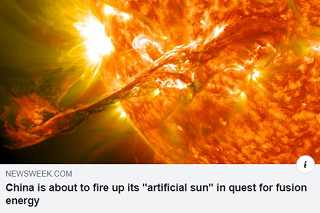Update on Nuclear Energy

OK, but what happens if fusion makes better and faster progress. Here, we’re talking about the processes that are occurring in the core of the sun, where the extreme temperatures (15 million degrees C) create the conditions where hydrogen atoms smash into one other with enough energy to fuse into helium atoms. Again, the products have less mass than the reactants, and again, an enormous amount of energy is released.
If either one of these happens, the world will have a limitless supply of clean energy, and all the stuff we’re doing with solar, wind, biomass, geothermal and hydrokinetics will be obsoleted.
As suggested above and explained here, the Chinese are developing a unique approach to fusion, heating hydrogen to over 100 million degrees C, at which point it becomes a plasma, then using magnetic fields to stabilize that plasma so fusion can occur in a controlled fashion that doesn’t damage the equipment.
The approach the Chinese are taking isn’t the only way to skin the nuclear fusion cat, but it appears to be the furthest along.
As much as I love the various flavors of renewable energy, I’ll be happy when they’re no longer required.
